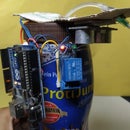Introduction: VIBRATION SENSOR
This is a type of sensor which sense the vibration int nearby places where it is placed and alert the person through a micro-controller. These types of sensor also known as piezoelectric sensor. It is always not easy to measure and calculate accurately the vibrations. Also advanced tools now a days are not able to give correct data to the consumers.
Earthquake are the vibrations in the tectonic plates of the earth but this is not possible to measure its vibration using this sensor. The one which I am using is(SW-420) the easily available and is used most commonly in the projects.
Step 1: WHAT IS VIBRATION SENSOR
Vibration sensor is designed with LM393 IC a VIBRATION ELEMENT a variable resistor to trim the value range of the value given by the sensor to the microcontroller.
Sensor also has an on-board Power led and an on-board Status led which will blink whenever the sensor detects the vibrations.
Vibration element is not a mysterious thing it is simply a PEIZOELECTRIC ELEMENT which is reduced to a very thin and compaq structure and hence known as vibration sensor. Piezo sensor is simple it generates a very small around 10mv which is then amplified by an op-amp and transferred to Micro-controller
*NOTE:- THIS SENSOR ISNOT THE BEST ONE MORE ADVANCED MODELS ARE AVAILABLE IN THE MARKET, ALSO THERE IS A EFFECT OF TEMP AND PRESSURE ON IT.
This sensor gives the output of DIGITAL type. I hope you know the difference b/w analog and digital type. In a whole at the digital pin of the digital it is 1(HIGH) when vibration is detected and 0(low) when it is still.
Step 2: SCHEMATIC
Step 3: USES
- Sensitivity is acceptable
- Easy to use
- Moderate range of sensing
- Adjustable value
- Low price
- Reactive to small vibrations also
NOTE:- Small vibration does not mean like very minute ones.
- Can be used in various projects
- Security purposes in museums
Step 4: PINOUT
Step 5: COMPONENTS REQUIRED
- Any microcontroller preferably Arduino Uno for beginners.
- A led
- A buzzer
- A vibration sensor
- A breadboard
- Jumper wires
- 1kohm resistor
Step 6: CONNECTIONS
First take the power lines onto the
bread board from microcontroller
VCC/5v-->+ line and GND--> - line.
Then connect the sensor on to the bread board and connect power to the sensor from powerlines using jumper wires.
Now connect D0 PIN OF SENSOR TO DIGITAL(PIN 3) OF THE MICROCONTROLLER.
Now connect a buzzer to the breadboard – wire to gnd and + wire to digital pin 2 of the microcontroller also connect a led parallel to the buzzer.
Step 7: CODE
//put this code in the ide of
arduino from this line
int vibration sensor=3; // initializing the digital pin
int buzzer=2;
int value;
void setup(){
Serial.begin(9600);
pinMode(vibration sensor, INPUT);
pinMode(buzzer, OUTPUT);
}
void loop(){
value=digitalRead(vibration sensor); // reading the digital dat from the sensor
digitalWrite(buzzer, value); // switching buzzer on or off
}
Step 8: WORKING
As the code starts it first initializes all the pins required and the variables required to save the necessary values. Then the sensor waits for the vibration to be felt.As soon as the vibration element detects the vibration it generates a small amount of electric potential which is then amplified by the op-amp and transferred to the microcontroller. Then the microcontroller according to the condition in the code turns the led and buzzer on or off.
Step 9: PCB DESIGN
Now we have got the PCB design and it’s time to order the PCB’s.
For that, you just have to go to JLCPCB.com, and click on “QUOTE NOW” button.
JLCPCB are also sponsor of this project. JLCPCB (ShenzhenJLC Electronics Co., Ltd.), is the largest PCB prototype enterprise in Chinaand a high-tech manufacturer specializing in quick PCB prototype and small-batch PCB production. You can order a minimum of 5 PCBs for just $2.
To get the PCB manufactured, upload the gerber file you downloaded in the last step. Upload the.zip file or you can also drag and drop the gerber files.
After uploading the zip file, you’ll see a success message at the bottom if the file is successfully uploaded.You can review the PCB in the Gerber viewer to make sure everything is good. You can view both top and bottom of the PCB.
After making sure our PCB looks good, we can now place the order at a reasonable price. You can order 5 PCBs for just $2 but if it’s your first order then you can get 10 PCBs for $2.
To place the order, click on “SAVE TO CART” button.
My PCBs took 2 days to get manufactured and arrived within a week using DHL delivery option. PCBs were well packed and the quality was really good.
*NOTE:- If you need pcb for this project than contact me or write me in the comment.





